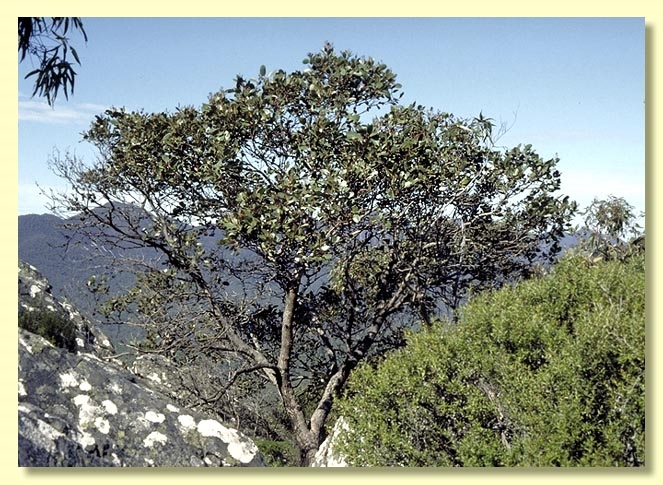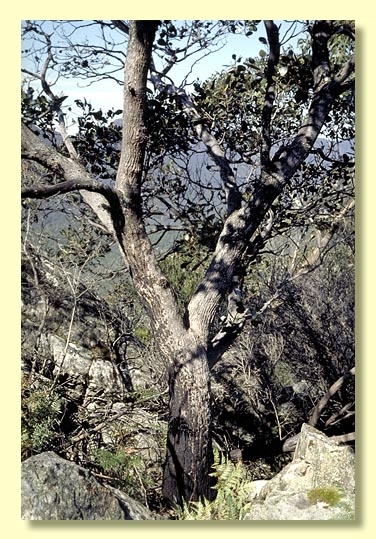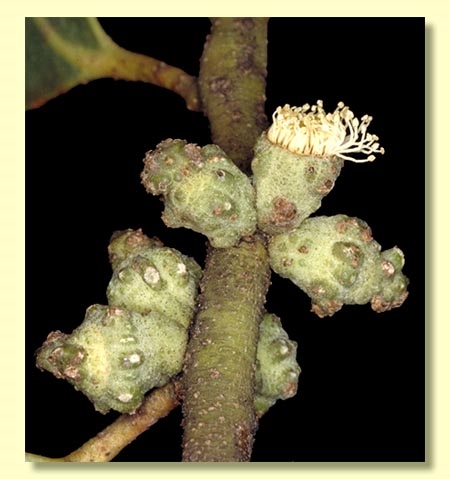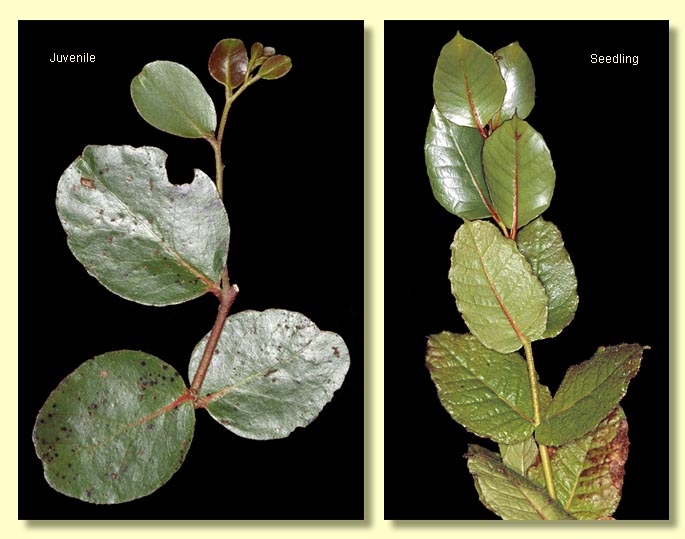Euclid - Online edition
Eucalyptus serraensis
Eucalyptus | Eucalyptus | Capillulus | Pachyphloius
T: Grampians, Vic., just N of carpark at Sundial Turntable, on a rocky outcrop, 30 Apr. 1987, M.R.Newnham & P.Y.Ladiges 943; holo: MEL.
[Eucalyptus alpina Lindley in T.L.Mitchell, Three Exped. Inter. Eastern Australia 2: 175 (1838). T: Summit of Mt William, Vic., July 1836, T.L.Mitchell 243; holo: CGE. This type specimen represents a plant of intermediate character between E. baxteri and [we presume] one or other of the taxa now known as E. serraensis and E. verrucata . For further information see Ladiges and Whiffin, Austral. Syst. Bot. 6: 365–6 (1993).]
Bark rough at least on trunk and often on limbs, firmly fibrous or quite hard, shallowly, longitudinally fissured, grey to grey-brown; smooth bark of branches brown or pale grey.
Juvenile growth (coppice or field seedlings to 50 cm): stem rounded in cross-section, scabrid; juvenile leaves opposite and sessile for 7 to 11 pairs then alternate, petiolate, orbicular to ovate, 5.5–7 cm long, 4.5–5.8 cm wide, lamina "bubbly" at first but later leaves flat, margin undulate becoming entire, apex rounded or emarginate, glossy, green, thick; stems and leaves scabrid until node 7–10 then scabrid only on petiole and midrib on underside, then entirely smooth.
Adult leaves alternate, petiole 1–3 cm long; blade ovate to orbicular to elliptical to lanceolate, 5–13 cm long, 2–7 cm wide, base oblique to tapering to petiole or rounded, concolorous, glossy, green, thick, side-veins acute, sparsely to moderately reticulate, intramarginal vein well removed from margin, oil glands obscure or very irregular, island.
Inflorescence axillary unbranched, peduncles 0–0.3 cm long, buds in umbels of 3 or 7, sessile. Mature buds ovoid, globular or oblong, 0.6–1.5 cm long, 0.5–1 cm wide, green, warty, scar absent, operculum conical to rounded or flattened, stamens irregularly flexed, anthers reniform to cordate, versatile, dorsifixed, dehiscing by confluent slits, style long, stigma tapered, locules 4 or 5, the placentae each with 2 vertical ovule rows. Flowers white.
Fruit sessile, hemispherical or cup-shaped, 0.6–1.7 cm long, 1–2 cm wide, disc raised-convex to annular, or level, valves 4 or 5, exserted or near rim level.
Seeds black or brown, 1.5–3.5 mm long, pyramidal or obliquely pyramidal, dorsal surface smooth, hilum terminal.
Cultivated seedlings (measured at ca node 10): cotyledons reniform; stems rounded in cross-section, stellate-hairy until ca node 8 to 10 then smooth; leaves sessile, opposite, cordate to ovate, stellate-hairy and discolorous for ca 7 to 11 nodes, then becoming petiolate and alternate and only scabrid on midrib on underside, 5–8.5 cm long, 3.5–5.5 cm wide, base amplexicaul at first becoming rounded to tapering at upper nodes, margin undulate, apex pointed, bright glossy green above, paler beneath.
Flowering has been recorded in February, April, August, September and December.
A small tree or mallee occurring only on very rocky sites in the Serra and Wonderland Ranges and Major Mitchell Plateau in the Grampians of western Victoria. Eucalyptus serraensis is a stringybark notable for the firmly fibrous rough bark. It has a crown of coarse, thick glossy green leaves, very warty buds and sessile fruit 1–2 cm wide. Juvenile growth is scabrid/hairy on lower leaves becoming thicker-leaved and glabrous up the stem.
Eucalyptus serraensis is related to two other Grampians endemic species, E. verrucata and E. victoriana, and to the more widespread E. baxteri. E. verrucata has buds solitary or in clusters of three (rarely seven and then solitary and 3-bud clusters predominate on the plant), and the buds are larger and more warty than in E. serraensis, whilst its fruit are 1.6–3.2 cm wide (only 1-2 cm wide in E. serraensis). Both E. serraensis and E. verrucata ultimately develop glabrous thick-textured juvenile leaves with rounded or notched apices and these leaves persist into the adult crown. E. victoriana, endemic to the Victoria Range to the west of the Grampians, differs in being a moderately tall tree with distinctly stringy bark over the lower trunk and smooth-barked upper trunk and branches, a glossy green crown of thickish leaves with rounded to pointed apices, axillary clusters of seven to 11 sessile, more or less angular and quite warty buds, and fruit 1–1.4 cm wide and with a prominently raised disc.
E. baxteri is a taller tree differing in always having distinctly stringy bark to the small branches, thin-textured adult leaves, axillary clusters of more than seven minutely warty buds, more rounded fruit 0.6-1.8 cm diameter.
There will be plants on the Major Mitchell Plateau and in the southern Wonderland and Serra Range that will not key to either E. serraensis or E. verrucata being of intermediate character.
MORE ABOUT STRINGYBARKS













